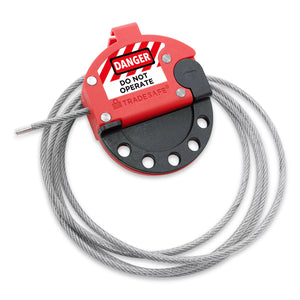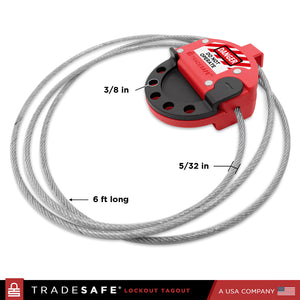Gate valve locks are typically designed to be able to cover the entire handwheel of a gate valve. To use one of these locks, simply open it up and fit the two halves over a gate valve’s handwheel. Make sure that the handwheel is in the off position.
You will then have to secure the two halves together with a personal safety padlock. You will also have to attach a tag to warn and provide pertinent information to other employees.
Who keeps the key when you perform lockout tagout?
Where is it best to store lockout tagout devices?
What must be written on lockout tagout tags?
Tags should include your name, department, contact information, and the date and time of tagging. Importantly, LOTO tags should include information on why they are being used.
Who can remove Danger Tags?
The standard lockout tagout procedure states that no one can remove a personal danger tag set by another individual. A personal danger tag can only be removed by somebody else or the supervisor if the person responsible is absent and they are certain that no damage will occur.
How do you install a cable lockout device?
Wrap the cable around a valve wheel, switch gear, or other energy-isolating device that you wish to be locked out. With the trigger released, run the cable back and insert to the lockout device’s body. Push the trigger to lock the cable and insert a padlock onto the hole with a tag.
Who can perform lockout tagout?
Only authorized employees are allowed to lock out and tag out machines or equipment. But some conditions must be met before a person may be deemed an authorized employee. For one, employers must provide proper LOTO training so that qualified employees have the knowledge and skills needed to correctly and safely install, use, and remove lockout tagout devices.Likewise, only the authorized employees who installed the devices have the authority to remove them. However, there may be times when a lockout tagout device must be removed and the employee who installed it is unavailable. In such cases, the employer must supervise another employee uninstalling the device.
How do you use lockout tagout devices?
Padlocks – Personal safety padlocks are used to secure lockout tagout devices such as valve locks, circuit breaker locks, plug locks, cable locks, and lock boxes. Each padlock belongs to an authorized employee and should be tagged with the owner's details.
Valve locks – Valve locks are used to secure valve handles and are locked with a personal safety lock, preventing employees from physically accessing the handwheel.
Circuit breaker locks – Circuit breaker locks prevent electrical circuits from being accidentally activated. Employees can install them by clamping them over circuit breaker switches. Then, personal safety padlocks must secure these locks.
Plug locks – A plug lock stops a machine from being plugged in, therefore preventing power from flowing into it. The plug lock encases the machine's plug, which is then secured with a padlock.
Cable locks – There are bound to be situations in which a switch or a valve is in a spot that’s difficult to access, making lockout tagout difficult as well. A cable lock is versatile and can be used in hard-to-reach areas, thus making lockout tagout possible.
Tags – Tags are an essential part of lockout tagout and should thus be included with every lock installed. They all come with a tie hole that allows them to be attached to locks. Additionally, they are writable and can be labeled with information about the lockout tagout procedure that’s underway.
Hasps – Hasps are versatile and can be used on lockouts for valves, circuit breakers, and a variety of machines. Each hasp comes with multiple padlock holes that allow multiple employees to lock out a single machine, valve, or panel.
Lock boxes– When personal safety padlocks are currently in use in a lockout tagout procedure, their keys can be stored and secured in a lock box. The lock box itself can also be secured by multiple padlocks belonging to all employees involved in the procedure. This ensures that no machine, valve, or panel will be re-energized until all employees are done with their lockout tagout tasks.
People Also Ask
How do you use a plug lockout device?
A plug lockout device keeps plugs from being inserted into an outlet, thus preventing an electric current from re-energizing a piece of equipment while under maintenance or repair. This protects workers from electrical shocks.
To use, open the plug lockout and insert the plug inside the case. There are holes on both ends of the device that fits the diameter of the cord. Close the plug lockout over the plug, secure with a padlock, and tag accordingly. TRADESAFE offers medium and large plug lockout devices that can store up to two plugs.
What are the different types of plug lockout devices?
There are three types of plug lockout devices:
- Plug lockout - This keeps the plug inside and prevents re-energization by disabling the plug from getting inserted into a wall outlet.
- Lockout cinch sack cover - This is primarily used for oddly sized large connectors and hoist controls. This comes with a cinch top to close and holes for padlocks.
- Power cord lockout – Compared to a plug lockout that keeps the plug inside the lockout device, a power cord lockout is directly inserted to the plug itself. It cannot be removed without a key, thus preventing the cord to be plugged into an outlet.
How do you use a cable lockout device?
Cable lockout is a versatile LOTO devices that’s often used in hard-to-reach locations or irregularly shaped energy devices because of its flexibility. Oftentimes, cable lockouts are made of steel cable or a non-conductive nylon cable. Nevertheless, they perform the same function. To use this lockout device, wrap the cable around the handles, switches, or controls of the device being locked out then run it back through the lockout body, cinch tightly, and secure with a padlock. The cable is usually several feet long to accommodate various machineries and equipment.
What is a lockout and how is it avoided?
Lockout refers to the process of shutting down energy sources properly, exhausting all energy that may be left since the last machine operation, and then securely putting a lockout device to prevent unexpected re-energization. Lockout is the first half of a lockout tagout procedure, which is mandated by OSHA in most industries. It forms part of the LOTO program that aims to enforce workplace safety practices. Therefore, it cannot be avoided.
How many types of lockout and tagout are there?
There are different hazardous energy sources for every industry. Each energy source needs to be locked out properly during maintenance or repairs to avoid workplace accidents. As the industry evolves, the need to maintain workplace safety has also changed. To date, the common types of lockout and tagout devices include padlocks, valve lockouts, breaker lockouts, plug lockouts, lock boxes, hasps, safety tags, and danger tags. As technology advances every day, new lockout and tagout devices may be developed to accommodate the LOTO needs of various industrial workplaces.
2 year no hassle guarantee
Real 24/7 direct support
Fast & Free Shipping
A USA based and owned company
Absorbent Supplies
Eyewash Stations
Lockout Tagout
Workplace Signs
More
Support
Follow us:
© 2019-2024 TRADEBASE OR ITS AFFILIATES
Chat
























